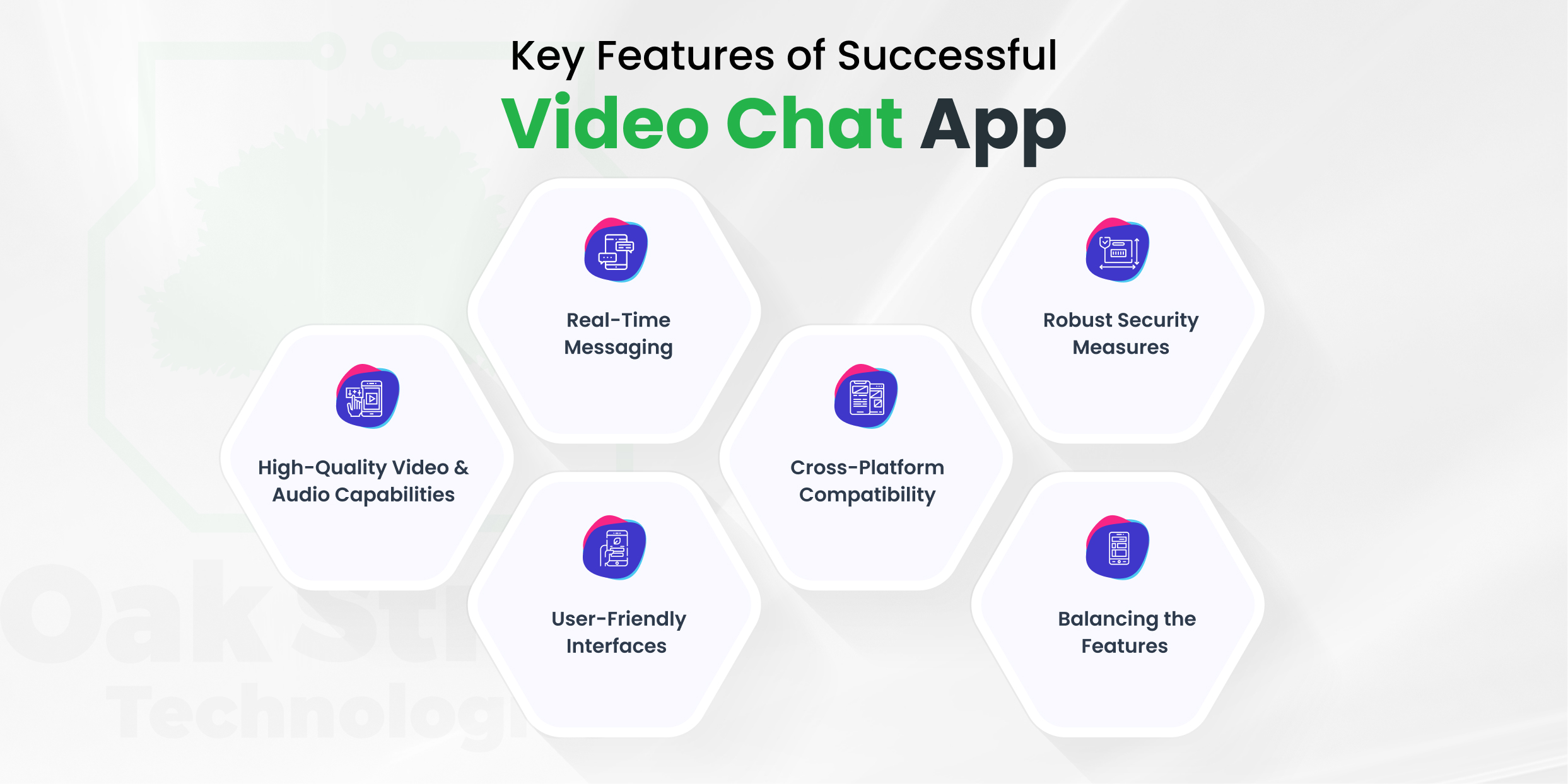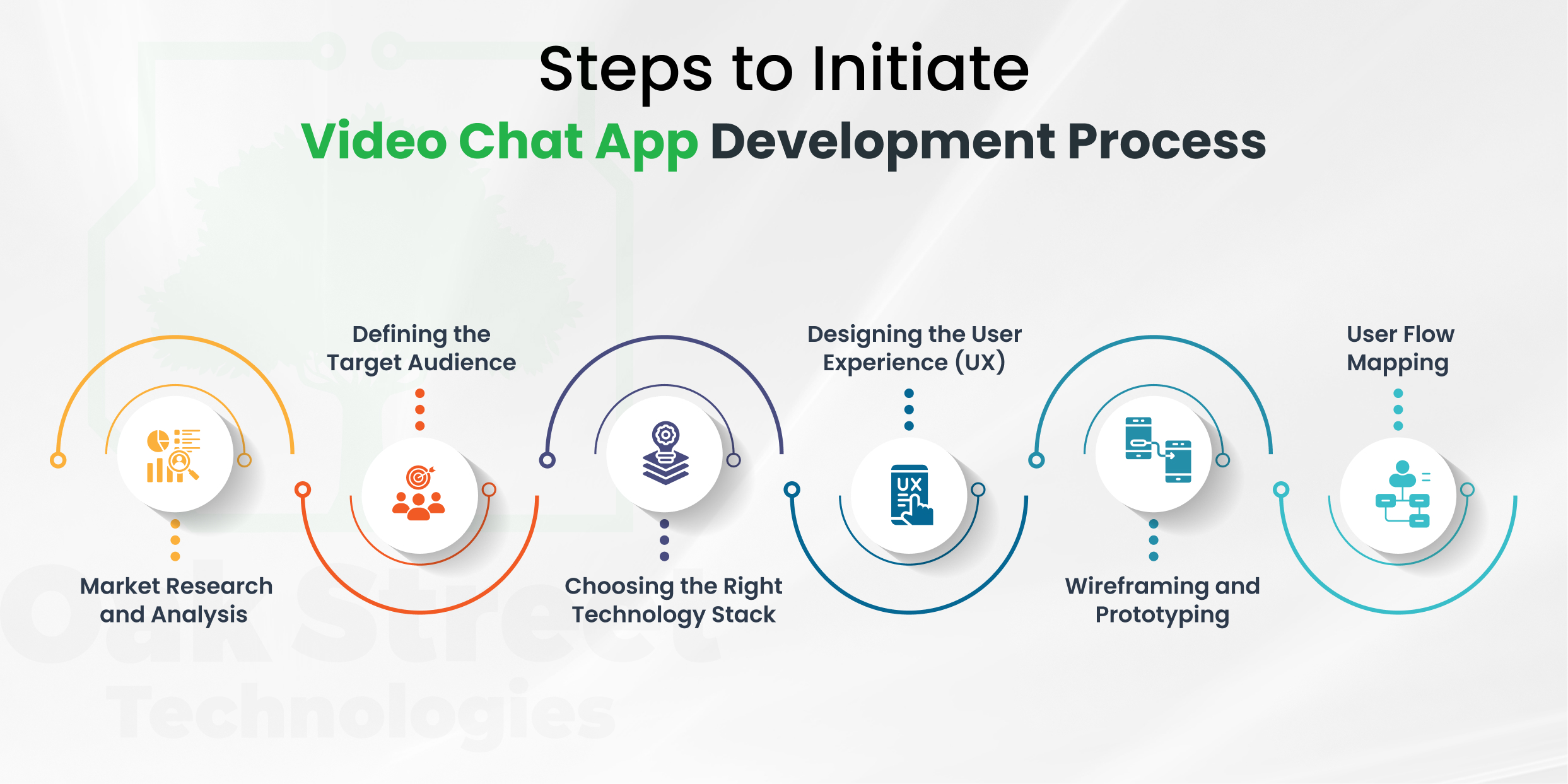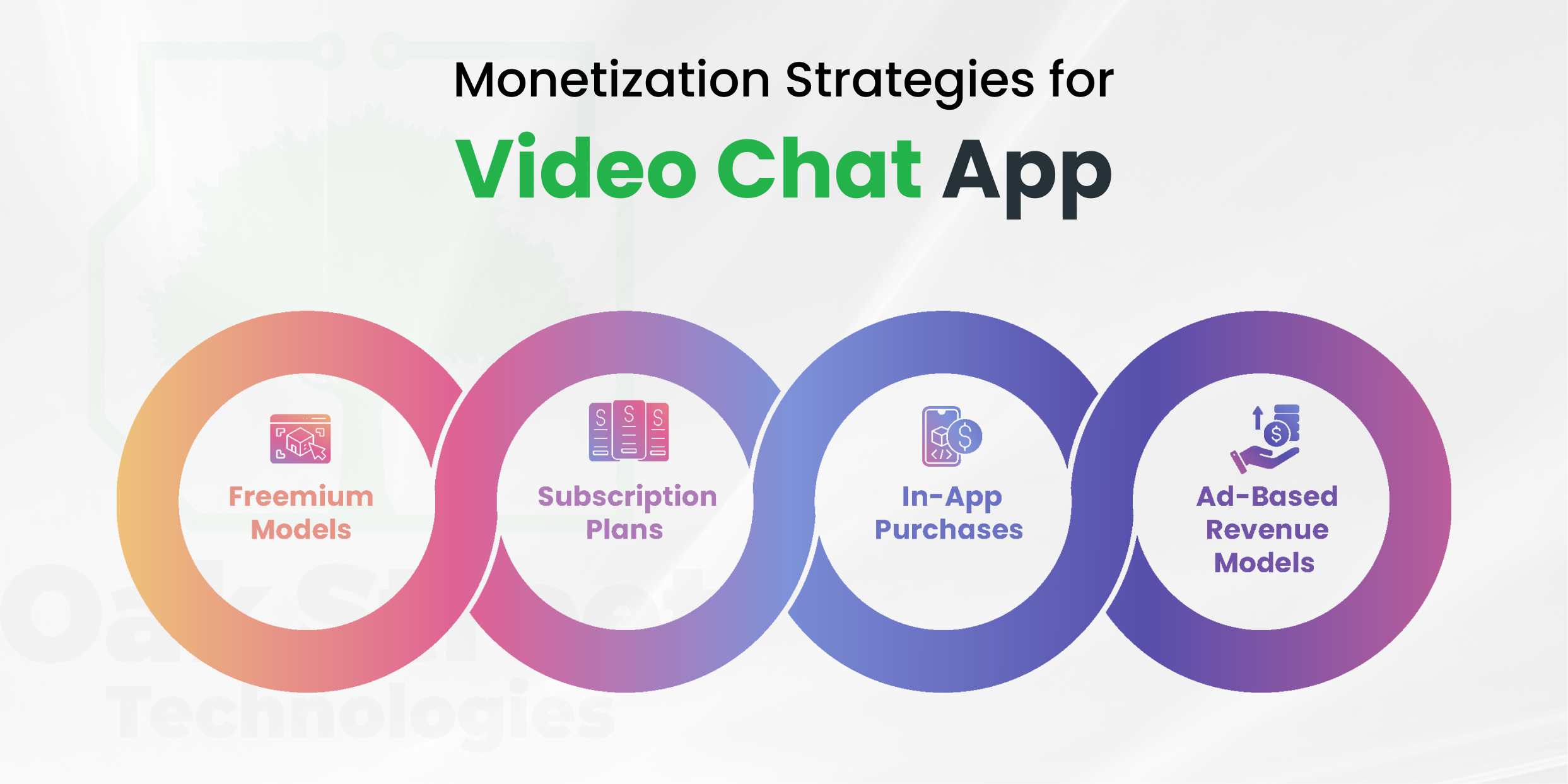Online messaging and video calling over the few years have become an indispensable part of daily lives. Initially, from being popular among family members and friends, nowadays it has become a vital part of every successful business. Particularly, given the increasing trend of remote work, its indispensability and efficacy are growing unprecedentedly as companies tend to integrate video calling into their mobile app. It only takes the assistance of a credible app development partner to materialize the idea into a well-functioning video chat app that exquisitely caters to your peculiar needs.
According to latest statistics, the video conferences market is valued at $4.2 billion and it is expected to reach $8.6 billion by 2027. This figure is reflective of the significance of video chat apps that have emerged as highly essential tools, bridging the gaps in personal and professional communication. This comprehensive guide navigates through the intricate process of developing a video chat app, from conceptualization to deployment. Understanding the nuances involved in each stage ensures a successful and user-friendly end product.
Key Features of Successful Video Chat Apps
Before diving into development, it is essential to grasp the key features that distinguish successful video chat apps. Here are a few key features:

High-Quality Video and Audio Capabilities
One of the primary distinguishing factors of successful video chat apps is the delivery of high-quality video and audio. Users expect clear and crisp visuals along with smooth, synchronized audio during their video interactions. This necessitates the utilization of advanced codecs, efficient compression algorithms, and adaptive streaming technologies to optimize video and audio quality based on varying network conditions.
Real-Time Messaging
Real-time messaging functionality enhances the overall user experience by allowing instantaneous communication alongside video calls. Users can share text messages, links, and multimedia content seamlessly while engaged in a video conversation. This feature fosters a more interactive and dynamic communication environment, facilitating the exchange of information in real-time.
User-Friendly Interfaces
The user interface (UI) of a video chat app plays a crucial role in attracting and retaining users. A user-friendly interface should be intuitive, visually appealing, and easy to navigate. Clear and accessible buttons, menus, and controls contribute to a seamless user experience, enabling users to initiate and participate in video calls effortlessly.
Cross-Platform Compatibility
In the diverse technological landscape, users access applications on various devices and platforms. Successful video chat apps prioritize cross-platform compatibility, ensuring that the app functions seamlessly across different operating systems and devices, such as iOS, Android, Windows, and macOS. This inclusivity broadens the app’s reach and user base.
Robust Security Measures
Security is paramount in video chat apps, considering the sensitive nature of the shared content and personal conversations. Robust security measures, including end-to-end encryption, secure authentication protocols, and regular security audits, are imperative to safeguard user data and maintain user trust. These measures mitigate the risk of unauthorized access and protect user privacy.
Balancing the Features
Achieving success in the competitive landscape requires a delicate balance of these key features. While ensuring high-quality video and audio, real-time messaging, user-friendly interfaces, cross-platform compatibility, and robust security measures, developers must also consider the overall user experience. The user interface should not only be functional but also aesthetically pleasing, contributing to an enjoyable and engaging user journey.
Steps to Initiate Video Chat App Development Process
The development process is a holistic strategy that requires thorough consideration and implementation of each step with due meticulous care. Here is the complete guide into the process:

Market Research and Analysis
The journey commences with thorough market research and analysis. Understanding the current landscape, user preferences, and competitor strengths and weaknesses is imperative to get a holistic view of the marketplace. This insight helps in identifying gaps in the market, allowing developers to tailor their video chat app to meet specific needs, preferences and in-vogue trends. A well-researched market analysis provides the very foundation for the video app, so do it should be carried out with due meticulousness.
Defining the Target Audience
One of the cornerstones of successful app development is a clear definition of the target audience – who the app is intended to and why. Factors like age, profession, and interests play pivotal roles in shaping the app’s design, features, and overall user experience. Tailoring the app to a specific demographic enhances its appeal and usability, increasing the likelihood of user adoption. The essence of a successful app lies in its ability to cater to all the possible requirements and demands of its target audience.
Choosing the Right Technology Stack
The choice of a technology stack is a pivotal decision that shapes the performance, scalability, and overall success of a video chat app. The technology stack comprises the programming languages, frameworks, libraries, and tools used in the development process. Selecting the right combination ensures a robust, efficient, and maintainable application.
Programming Language: The programming language is the foundation of any software development project. For video chat app development, languages like Swift or Objective-C for iOS and Java or Kotlin for Android are commonly used. Cross-platform frameworks like React Native or Flutter can be considered for simultaneous development on both platforms.
Frontend Frameworks: Choosing the appropriate frontend framework is essential for creating a responsive and visually appealing user interface. React.js and Vue.js are popular choices due to their component-based architecture, facilitating the creation of dynamic and interactive interfaces. These frameworks enable developers to efficiently manage the real-time updates required for video chat applications.
Backend Frameworks: On the server side, frameworks like Node.js, Django, or Ruby on Rails can be employed. Node.js is particularly well-suited for handling real-time communication through its event-driven architecture. The choice of the backend framework should align with the expertise of the development team and the scalability requirements of the application.
WebRTC (Web Real-Time Communication): WebRTC is a critical technology for enabling real-time communication in video chat apps. It provides APIs for building real-time audio and video communication applications directly in web browsers. Leveraging WebRTC ensures low latency and high-quality video streaming, enhancing the overall user experience.
Database: The selection of a database depends on the complexity of data management and scalability requirements. Relational databases like PostgreSQL or MySQL are suitable for structured data, while NoSQL databases like MongoDB or Cassandra can handle large volumes of unstructured data generated by video chat apps.
Cloud Services: Integrating cloud services is crucial for scalability, storage, and data management. Platforms like AWS (Amazon Web Services), Google Cloud Platform, or Microsoft Azure offer a range of services such as cloud storage, serverless computing, and database solutions, facilitating the seamless functioning of video chat applications.
Designing the User Experience (UX)
User experience (UX) design is a critical aspect of video chat app development, influencing user engagement and satisfaction. A well-designed UX ensures that users can seamlessly navigate the app, access features, and enjoy a visually appealing interface.
User-Centric Design: Start by understanding the needs and preferences of the target audience. User personas and journey maps can aid in creating a design that aligns with user expectations. Prioritize simplicity and intuitive navigation to enhance the overall user experience.
Responsive Design: Video chat apps should be accessible across various devices and screen sizes. Implementing responsive design principles ensures that the app adapts to different platforms, providing a consistent and user-friendly experience whether on a smartphone, tablet, or desktop.
Intuitive Navigation: The app’s navigation structure should be intuitive and straightforward. Users should be able to access core features with minimal effort. Clear and concise menus, buttons, and navigation paths contribute to a positive user experience.
Real-Time Updates: Given the real-time nature of video chat apps, providing instant updates and feedback is crucial. Implement features like typing indicators, read receipts, and connection status indicators to keep users informed about ongoing interactions.
Personalization: Integrate personalization features to enhance user engagement. Allow users to customize their profiles, set preferences, and personalize the app’s appearance. Personalized experiences contribute to a sense of ownership and connection with the app.
Wireframing and Prototyping
Before diving into the actual development, creating wireframes and prototypes is a crucial step to visualize the app’s structure, layout, and functionality. This iterative process allows for early feedback and adjustments, saving time and resources in the long run.
Wireframing: Wireframes are skeletal outlines of the app’s interface, showcasing the placement of elements, navigation paths, and overall structure. Tools like Sketch, Adobe XD, or Figma are commonly used to create wireframes. Focus on basic functionality and layout to establish a foundation for the design.
Prototyping: Prototypes add an interactive layer to wireframes, allowing stakeholders to experience the app’s flow and functionality. Prototyping tools like InVision or Proto.io enable the creation of clickable prototypes. This stage is critical for identifying design flaws, ensuring smooth user flows, and obtaining valuable feedback from stakeholders.
User Testing: Conduct user testing sessions with the prototypes to gather insights on usability and identify potential improvements. Feedback from real users at this stage helps in refining the design before moving into full-scale development. Iterative testing and refinement contribute to a more polished and user-friendly application.
User Flow Mapping
User flow mapping involves outlining the sequence of interactions a user will have within the app. This visual representation helps in identifying the pathways users will take to achieve specific goals, ensuring a logical and intuitive navigation experience.
Identifying Key Interactions: Start by identifying the primary interactions users will engage in, such as initiating a video call, sending messages, or adjusting settings. Understanding these key interactions is essential for mapping out the user flow.
Defining User Paths: Map out the different paths users can take to accomplish tasks within the app. Consider various scenarios, such as starting a new chat, joining a video call, or accessing multimedia content. Each path should have a clear and logical progression.
Visualizing Decision Points: User flow maps should highlight decision points where users make choices that impact their journey through the app. This could include deciding whether to join a group chat or initiate a private conversation. Visualizing decision points aids in creating a seamless and user-friendly flow.
Also Read About: Social Media App Development Cost
Iterative Refinement: User flow mapping is an iterative process that evolves with feedback and testing. As the app progresses from development to testing stages, revisit and refine the user flow map based on real-world usage and user feedback. This ensures that the app aligns with user expectations and provides a satisfying experience.
Choose Development Platforms and Technologies
Choosing the development platforms and technologies is an immensely pivotal decision that influences the accessibility and performance of the video chat app. Consideration must be given to the target audience and the desired reach across different devices and operating systems. To this end consider factors such as:
iOS and Android Platforms: Determine whether the app will target a specific platform or both iOS and Android. Development for each platform involves using platform-specific technologies – Swift or Objective-C for iOS and Java or Kotlin for Android. Alternatively, cross-platform frameworks like React Native or Flutter can be utilized for simultaneous development.
Cross-Platform Development: Cross-platform development frameworks offer the advantage of writing code once and deploying it on multiple platforms. React Native, Xamarin, and Flutter are popular choices. These frameworks streamline development efforts, reduce time-to-market, and ensure a consistent user experience across platforms.
Integration of Essential APIs: Consider the integration of essential APIs for enhanced functionality. APIs for real-time communication, video streaming, and authentication are critical for the seamless operation of a video chat app. WebRTC, Firebase, and OAuth are examples of APIs commonly integrated into video chat applications.
Scalability: Scalability is a key consideration when choosing development platforms. Ensure that the selected platforms and technologies can accommodate potential increases in user numbers without compromising performance. Cloud services and serverless architectures are viable options for scalable solutions.
User Accessibility: Opt for platforms and technologies that prioritize user accessibility. The app should be designed to be inclusive, considering users with different abilities. Compliance with accessibility standards ensures a broader user base and positive user experiences.
The choice of development platforms and technologies sets the stage for subsequent development phases; therefore, it needs to be dealt with due meticulousness.
Testing and Quality Assurance
In the iterative journey of video chat app development, the phases of testing and quality assurance (QA) are paramount. These stages serve the purpose of ensuring a flawless user experience, identifying and rectifying bugs, and upholding the application’s reliability and functionality.
Some of the testing types include the following:
Functional Testing: This involves a meticulous examination of all features and functionalities to ensure they perform as intended. From video and audio quality assessments to real-time messaging, functional testing encompasses the core functions of the video chat app.
Usability Testing: The focus here is on the user interface, assessing its intuitiveness and ease of navigation. This type of testing aims to identify areas for improvement in the overall user experience.
Performance Testing: The app’s performance under diverse conditions, including different network speeds, is rigorously evaluated. This ensures that video streaming remains smooth, and there is minimal lag during calls.
Security Testing: An integral aspect that focuses on identifying vulnerabilities and weaknesses in the app’s security measures. It validates the effectiveness of encryption protocols and secure data transmission.
Compatibility Testing: This ensures that the app functions seamlessly across a diverse range of devices and operating systems. It addresses potential issues related to different screen sizes and resolutions.
Regression Testing: Ensuring that new updates or features do not negatively impact existing functionalities. It aims to detect and resolve any unintended side effects of code changes.
Security Measures in Video Chat App Development
Security considerations take center stage in video chat app development, given the sensitive nature of communication involved. Implementing robust security measures is imperative to safeguard user data, ensure privacy, and build and maintain user trust.
Key security measures include:
End-to-End Encryption: This crucial security feature encrypts communication data, ensuring that only the intended recipients can access the information. It serves as a critical layer of protection for user conversations, preventing unauthorized access.
Secure Authentication Mechanisms: Implementation of secure login processes, including multi-factor authentication, to prevent unauthorized access to user accounts. This strengthens the app’s defenses against potential security breaches.
Regular Security Audits: Periodic audits are conducted to proactively identify and address potential vulnerabilities. This ongoing commitment to security ensures that the app adapts to emerging threats and maintains a robust security posture.
Compliance with Data Protection Regulations: Adherence to data protection regulations, such as GDPR, is crucial. This ensures that user data is handled responsibly and legally, building user trust through a commitment to privacy.
User Education on Security Best Practices: Users are educated on the best practices for maintaining account security. This proactive measure raises awareness about potential risks and encourages users to take preventive measures.
Monetization Strategies for Video Chat Apps
Monetizing a video chat app involves a thoughtful and strategic approach, aligning with user expectations while achieving business goals. Here, we explore different monetization strategies:

Freemium Models
Freemium models entice users by offering basic features for free while providing premium features, such as high-definition video or extended call durations, through a paid subscription. This approach aims to attract a broad user base with free offerings while generating revenue from users willing to pay for additional features.
Subscription Plans
Subscription plans involve users paying a recurring fee for ongoing access to premium features. These plans often come with tiered pricing, offering different levels of features at varying price points. Subscription plans provide a predictable and recurring revenue stream while encouraging user loyalty through continued access to premium features.
In-App Purchases
In-app purchases allow users to make one-time purchases within the app, enhancing their experience with additional features or virtual goods. This flexible monetization model caters to users who prefer making occasional purchases, allowing them to customize their video chat experience based on personal preferences.
Ad-Based Revenue Models
Ad-based revenue models integrate non-intrusive advertisements within the app, generating revenue through ad impressions, clicks, or interactions. Ads are strategically displayed during non-intrusive moments, such as between calls or in-app notifications. Users may have the option to opt for an ad-free experience through a premium subscription, offering a supplementary income source alongside other monetization strategy.
Case Studies: Successful Video Chat App Development Stories
Meanwhile, successful video chat apps have demonstrated the transformative power of innovative ideas, seamless user experiences, and strategic development. Examining the journeys of these apps provides valuable insights into the dynamics of the industry and the factors contributing to their success.
1. Zoom
Zoom is a prime example of how a video chat app can transcend its initial niche and become a global phenomenon. Initially designed for business meetings, Zoom’s user-friendly interface and robust features quickly garnered widespread adoption across various sectors.
Key Features of Zoom include:
- High-quality video and audio conferencing
- Screen sharing for collaborative work
- Virtual backgrounds for customization
- Chat functionality for real-time communication
2. WhatsApp
While WhatsApp started as a messaging app, the addition of video calling features transformed it into a comprehensive communication platform. WhatsApp’s success lies in its ability to integrate video calling seamlessly into its existing ecosystem of features.
Key Features of WhatsApp:
- End-to-end encryption for enhanced security
- Group video calls for social and business interactions
- Cross-platform availability
- Multimedia sharing within chats
Conclusion
To sum it up, the development of a successful video chat app involves a multifaceted approach, from careful planning and user-centric design to the strategic choice of technology stack and platforms. Successful video chat apps prioritize user experience, adaptability, and innovative features. As the demand for video chat applications continues to grow, developers should embrace a holistic approach that combines technological innovation with user-centric design principles. By staying attuned to market trends, addressing security concerns, and incorporating lessons from successful case studies, developers can navigate the complexities of video chat app development more effectively.
Ready to translate your idea into reality & have a desired video chat app developed? You are just a click away to realize your dream as OakStreet Technologies is here to assist. Our app development services are known for innovation, scalability, and robustness, bringing to the table the best-in-class app tailored perfectly to your needs and demands. Contact us today!



